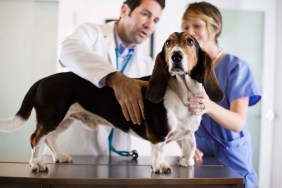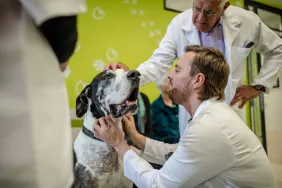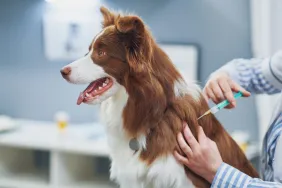Fibrocartilaginous Embolism (FCE) in Dogs: Symptoms, Causes, & Treatments

Fibrocartilaginous embolism (FCE) in dogs is a medical condition that happens when blood vessels become blocked. Technically, the cause of the blockage is fibrocartilage which is found in the discs between a dog’s vertebrae. Additionally, the condition is also referred to as a spinal stroke.
Generally, the disorder affects adult dogs more than young pups. Also, larger and giant dogs seem to be prone to developing the condition. Additionally, certain breeds — including Shetland Sheepdogs and Miniature Schnauzers — often suffer from fibrocartilaginous embolism.
If you see signs that your dog might be suffering from this condition, then you must consult your veterinarian for a proper diagnosis and course of treatment. Here’s what you should know about the symptoms, causes, and treatments of fibrocartilaginous embolism in dogs.
Symptoms of fibrocartilaginous embolism in dogs
Spinal stroke in dogs can result in a range of symptoms. Usually, a canine develops symptoms while playing or walking.
@media (min-width: 0px) and (max-width: 749px) { .pb_prebidjs_300x250_a__wrapper { min-height: 250px; } } @media (min-width: 750px) { .pb_prebidjs_300x250_a__wrapper { display: none; } }
For instance, some of the most common symptoms of the condition include:
- Lameness
- Collapsing
- Barking out of pain
- Limbs becoming weak; acute onset weakness
- Not being able to pee
- Dragging a limb along; paralysis
- Fecal incontinence
Causes of fibrocartilaginous embolism in dogs

The cause of spinal stroke is fibrocartilage blocking a blood vessel. Technically, this happens in a dog’s spinal artery.
Usually, a dog playing, walking, or jumping exacerbates the condition, especially during games like frisbee. Following vigorous exercise, symptoms of FCE may come on suddenly.
Additionally, the following breeds seem most likely to develop the disorder:
- Yorkshire Terrier
- Shetland Sheepdog
- Miniature Schnauzer
- Bernese Mountain Dog
- Labrador Retriever
Finally, male dogs seem to be more affected by the condition than female dogs. Also, some studies suggest older adult dogs experience it more than young ones.
Treatments for fibrocartilaginous embolism in dogs
Firstly, if you think that your dog might be developing the disorder, your veterinarian will want to carry out a full physical examination of your dog. Additionally, your vet will ask about your dog’s complete medical history. This will include any breed-specific problems.
Secondly, your dog will undergo neurological and reflex tests. Additionally, a combination of X-rays, MRIs, and spinal fluid tests can help to confirm the condition.
Unfortunately, there is no standard treatment for fibrocartilaginous embolism. However, physical therapy can be a big help. For example, massage, hydrotherapy, and muscle stimulation can all be tried. However, be sure to remember that recovery can take three or four months in some cases, so be patient with your canine.
Additionally, if your pup cannot pee due to the condition, your vet will help to express their bladder. This is also something you might need to continue to do while your dog recovers at home. Your vet will teach you how to carry out the process.

Cephalexin for Dogs: Uses, Dosage, & Side Effects

Bone Cancer in Dogs: Symptoms, Causes, & Treatments

Canine Influenza: Symptoms, Causes, & Treatments

Mastitis in Dogs: Symptoms, Causes, & Treatments

Dog Breath Fresheners: What To Know

Puppy Impetigo in Dogs: Symptoms, Causes, & Treatments

What a Dog’s Tail Is Telling You




